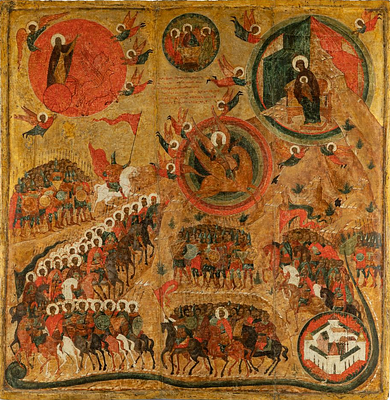Russian School of Mstera, 18th century. "The Virgin of the Burning Bush. Tempera, gold leaf on panel.
Lot 31
About Seller
Setdart Auction House
Carrer Aragó 346
Barcelona
Spain
Setdart Subastas was born in 2004 and is currently the first online art auction in Spain with solidity, prestige and reliability guaranteed by our more than 60,000 users. Setdart has a young, dynamic and enterprising team ready to successfully manage the purchase and sale of art works through custom...Read more
Estimate:
EUR€1,500 - EUR€1,800
$1,562.50 - $1,875
Absentee vs Live bid
Two ways to bid:
- Leave a max absentee bid and the platform will bid on your behalf up to your maximum bid during the live auction.
- Bid live during the auction and your bids will be submitted real-time to the auctioneer.
Bid Increments
| Price | Bid Increment |
|---|---|
| EUR€0 | EUR€10 |
| EUR€200 | EUR€25 |
| EUR€500 | EUR€50 |
| EUR€1,000 | EUR€100 |
| EUR€3,000 | EUR€200 |
| EUR€5,000 | EUR€500 |
| EUR€10,000 | EUR€1,000 |
| EUR€20,000 | EUR€2,000 |
| EUR€50,000 | EUR€5,000 |
About Auction
By Setdart Auction House
Sep 23, 2021
Set Reminder
2021-09-23 10:00:00
2021-09-23 10:00:00
America/New_York
Bidsquare
Bidsquare : RUSSIAN ICONS
https://www.bidsquare.com/auctions/setdart-auction-house/russian-icons-7431
Setdart Auction House sofia@setdart.com
Setdart Auction House sofia@setdart.com
- Lot Description
Russian School of Mstera, 18th century. "The Virgin of the Burning Bush. Tempera, gold leaf on panel. Measurements: 22 x 19 cm. The Virgin of the Burning Bush is one of the most complex and symbolic icons of the Marian theme in orthodox iconography. It alludes to the passage of the same name from the Old Testament. On the symbolic level it develops different facets of Christian worship related to the appearance of Christ, based on the Old Testament stories. This iconography has been known since proto-Christian times, when the Praying Virgin, or in some cases the Odigidria, was depicted enclosed in the Burning Bush, with Moses kneeling and contemplating her. In the mid-16th century, coinciding with the rule of Ivan the Terrible, the icon of the Virgin of the Burning Bush changed its appearance, enriched with symbols and allegories. At that time Old Russia was undergoing a major expansion of its territory towards Siberia, Astrakhan and Kazan. Russia has become the most important Orthodox centre in the world. The Virgin and the Burning Bush came to be depicted half-length, holding the Child Jesus in her arms, within a two-coloured eight-pointed star, which is composed of two rectangles, red, symbolising the Burning Bush, and green, symbolising the growing bush, or blue, as in the case of the auctioned icon, a less common representation, which alludes to the sky. In the corners of the red rectangle are depictions of an angel, an eagle, a lion and an ox, mentioned in the Apocalypse of St John the Evangelist. In the case of the icon of interest, the image of the lion is partially lost, but even so it is clear that it is a canonical icon. Another theme of the icon is the service of the angels to the Mother of God, and the adoration of the heavenly powers for the miraculous birth of Christ, their images arranged on the rays of the eight-pointed star. Among them are the archangels and nameless angels. The gold polychrome border of the icon, a symbol of heaven and divine power, is left free of any detail, leaving the central register of the image to take centre stage. The only detail that can be seen is the inscription in Cyrillic - "Neopalimaya Kupina" - which in its literal translation into English means the title of the icon itself, "The Virgin of Burning Bush". This icon was produced in the workshops of Mstera, one of the most important schools of icon painting in Russia, both in terms of the quantity and quality of its production. This village is located near Vladimir, another of the most important icon-painting schools, and the first mentions of it date from around 1628. It was a poor location, and its inhabitants, mainly peasants, alternated their farming activities with various crafts for a living. Since Mstera was surrounded by monasteries and churches, icon painting was the most common activity. Thus, by the 19th century, more than half of the population was engaged exclusively in icon painting. The speciality of this school was to follow the ancient styles, its icons are distinguished by the abundance of details, both in the depiction of saints and in the representation of nature, but at the same time the aesthetics of the characters could be described as naïve. Apart from painting the icons en masse, the masters of Mstera were also first-class restorers. Therefore, this great knowledge of the material means that the icons of this school are always of a high quality.
- Shipping Info
-
In-house shipping available. Please inquire at admin@setdart.com.
-
- Buyer's Premium



 EUR
EUR CAD
CAD AUD
AUD GBP
GBP MXN
MXN HKD
HKD CNY
CNY MYR
MYR SEK
SEK SGD
SGD CHF
CHF THB
THB















